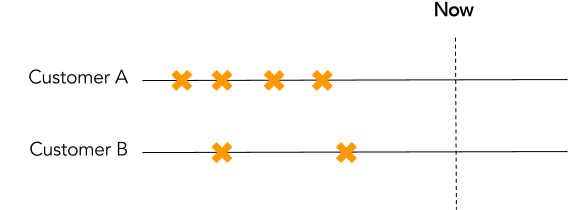A guide to utilizing LTV data to maximize optimization potential

Calculating lifetime value
The focus of this article is how we can utilize Lifetime Value data, not calculate it. The methodology of calculating Lifetime Value could be discussed at great length. For a good primer on calculating LTV, I highly recommend Avinash Kaushik’s excellent overview.
For the purposes of this article, we’ll make the assumption that you have an excellent analytics team helping you calculate lifetime value, but there are a few things you should keep in mind as you work with them.
How are we defining “lifetime”?
Historical lifetime value vs. residual lifetime value vs. predictive lifetime value
Lifetime value is a predictive value of the revenue generated by a relationship with a customer over their lifetime interaction with the company. As a forward-looking concept you can’t know how much it is; it has to be modeled/predicted. However, often the average revenue per user to date will be referred to as LTV. This can be thought of the Historical LTV. As a backward-looking metric, it describes the average revenue generated per user so far in their lifetime. Historical LTV doesn’t take into account a user’s future revenue and has no predictive elements. Historical LTV ignores Residual LTV, which is the amount of revenue that remains to be generated by the customer. This value is predictive.
This can be visualized by considering two hypothetical customers:

Looking at these users, Customer A may have the higher Historical LTV, but Customer B may have higher Residual LTV, and therefore a higher LTV. Customer A may purchase more items quickly than Customer B, but customers like Customer B may purchase more slowly, but at a higher Average Order Value and maintain a longer lifetime than customers that look like Customer A. The main thing you need to keep in mind when considering LTV data you are using for optimization is: what does it actually represent?
- Predictive LTV: As this is modeled data, it is important to keep in mind that the modeling is only as good as the data utilized to model the results. For cohorts based on new tactics or small sample sizes, modeling error is likely to increase. This means you should be more wary when using that data for optimization.
- Historical LTV: When using historical LTV (or average revenue per user), the key thing to keep in mind is understanding that different cohorts may be influenced by different time frames. For example, ARPU for users whose first touch is PPC non-brand vs. display may be higher for PPC non-brand because the average lifetime days for that cohort of users is higher. This can accounted for by defining a set cohort window, for example the first 360 lifetime days, and excluding users who have had less than 360 lifetime days, or by defining a cohort by acquisition month, for example users acquired in January 2014.
- Residual LTV: It’s fairly unlikely that residual LTV will be the provided metric, but it can be particularly useful for retention campaigns (more below) to determine how much spend should be focused on retaining those users.
How we are defining the cohorts of users?
To make lifetime value useful, we want to segment the customer base by different characteristics. For example, what is the lifetime value of users acquired by Facebook versus Google. As digital marketers, we are particularly concerned with attribution for this segmentation. Is the channel that acquired a user the channel through which they first interacted with the brand, or the channel that closed their first purchase? These determinations will adjust how we segment the user base and the insights generated.
What touch to choose?
Imagine a consumer (Ned) who wants to buy a pair of running shoes. Ned searches on Google the non-brand query “best running shoes for overpronation” and clicks on a paid search ad for a running shoe manufacturer. Ned is quite a considerate purchaser, so he takes a few weeks to look at different options before seeing a retargeting ad on Facebook and clicking on the ad to convert. If we are to place Ned in a cohort by last click, then he would belong to the Facebook campaign cohort; however, if we place him in a cohort by first click, then he would belong to a non-brand campaign cohort. Do we optimize towards that initial campaign that acquired Ned, or the campaign that converted him?
It isn’t essential to choose one or the other, but it is important to test both approaches to see what approach is better to optimize towards. Note: this may vary on a company-by-company basis.
Channel and campaign characteristics
Different channels and campaigns are going to have inherent characteristics that mean users acquired from those channels are likely to have higher LTV.
For example, users acquired via paid search brand campaigns are likely to have a high LTV, as the fact they searched the brand explicitly show they already have high brand awareness and are likely to be high-consideration purchasers. Channels like consumer shopping engines tend towards lower LTV as those users have low brand affinity and potentially low consideration in their purchase. Competitor keywords also tend towards lower or more volatile LTV numbers as users acquired by those channels have a higher churn propensity. (They have at least some awareness of a competing product-that’s how you acquired them!)
Beyond single touch
Cohort definitions don’t need to be just as simple as First Touch or Last Touch. Returning to our consumer shopping engine example, while it may be the case that consumer shopping engines acquire lower-LTV customers, it may be that a customer who is acquired via a consumer shopping engine and builds brand affinity and then converts on their second purchase via a PPC brand ad is actually a very high-value customer. We can then optimize our sequential targeting strategy to identify and drive more of these particular customers.
Optimizing campaigns
Now we have a clear sense of how the lifetime value data is defined, we can utilize that data to start optimizing campaigns.
Optimizing for paid search
Optimizing paid search by keyword is a particularly strong use case for LTV optimizations as bidding is set at the keyword level and is a large part of the optimization process.
Before you start optimizing
Once Lifetime Value by keyword is calculated, first it is helpful to examine how much LTV variance by keyword exists in the dataset. If there is little variance, then it is unlikely that keywords have much of an impact on LTV, so it may not be a valuable exercise to try and optimize towards keywords.
Identify favorable CAC:LTV ratios
Once you have Lifetime Value data, the key is finding Ad Campaigns or Groups with a favorable ratios of CAC:LTV, so where the lifetime value of a new customer exceeds the cost of acquiring that customer. Reasons that an ad group could have a strong ratio include:
- An ad group is attracting unusually high-value customers
- There is low competition for an ad group, so there is a low average cost per click, leading to a favorable ratio
Identify high-potential campaigns
Now that the ad groups with strong CAC:LTV ratio have been identified, it is important to determine how much increased investment will move the needle. If a particular campaign is in the top position already, then increased bidding won’t actually help acquire more customers. Generally it is best to focus on opportunities where the average bid position is below 1.5 in order to identify the cases with greatest opportunity. The hypothesis is that increased bidding on these keywords will be balanced out by the LTV of customers acquired by these keywords.
Optimizing other channels
Beyond paid search, it is also possible to optimize other channels like display or paid social. Look for campaigns, ad sets, creatives, or audiences that have a strong CAC:LTV ratio. You can then optimize spending on high LTV tactics to allow a higher CAC.
Creating a feedback loop
It’s important that optimization towards LTV is not done as a one-off activity and is part of a feedback loop. It is likely that CPAs will increase from LTV-focused strategies as you move from buying low-value customers to high-value customers, so it is key that those customers are tracked through to whatever system you are using. New campaign-level CPA targets should be set.
For example, if you were to switch from targeting low-value keywords and paying $1/customer to high-value customers at $2/customer, then things won’t look so great in AdWords. Your conversion numbers will drop as your CPA increases. However, if those users then drive 4x more revenue, overall ROAS increases by 100%.
Ideally a monthly repeating process can be set up to review new customers acquired via the campaigns being tested against and track whether these users are on track to maintain their estimated CAC:LTV ratio.
It’s not just acquisition
Lifetime Value data isn’t just about driving acquisition. It can also be used to help focus and optimize retention campaigns. If a particular cohort of users is likely to have higher LTV, then it is worth focusing retention dollars on those users to make sure they do not churn, whereas users with a lower LTV might be excluded from retention.
Lookalike audiences
Lifetime Value data can also be utilized to build custom audiences and lookalike models. For example, by creating a lookalike audience off the top 10% of customers by LTV, it can be possible to optimize towards highly valuable customers. Platforms like Facebook have the ability to include this as a variable in the custom list uploaded to Facebook.
Conclusion
These tactics should lay a strong foundation to start optimizing campaigns towards lifetime value and moving from optimizing away from short-term gains to long-term value. To recap, the key steps are:
- Defining your cohorts and calculating lifetime value
- Calculating the ratio of cac:ltv and identifying campaigns with strong cac:ltv ratios
- Optimizing those high-value campaigns
- Creating an “always be testing” culture to continually monitor LTV and feed those learnings back into your campaigns
Learn more about our data & intelligence offering.
Explore
Questions?


